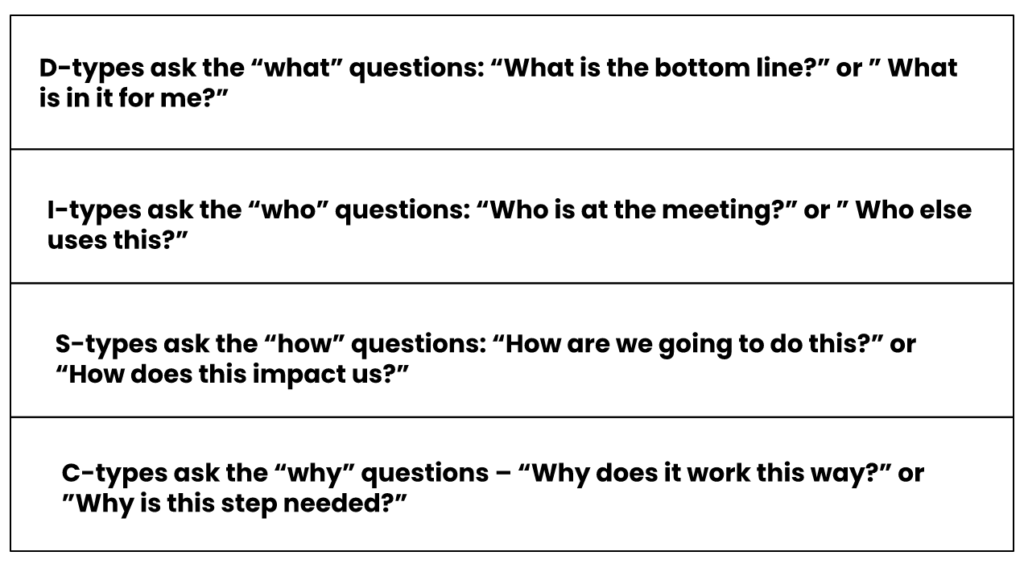Understanding Our Patients’ Personality Traits And Behaviors, As Well As Our Own, And How It Improves Communication
Based on our reactions to various environments, DISC identifies our preferred behaviors. Tailoring our communication styles to those we are speaking with helps to build trust, which leads to the desired outcome.
DISC, in a nutshell, helps us understand why we do what we do.
What Exactly is DISC?
The acronym DISC stands for various personality profiles.
- D – Dominance – How we solve problems (strong personalities)
- I – Influence – How we relate to others (social butterflies)
- S – Steadiness – Our pace and energy level (great listener, serves others)
- C – Conscientiousness – How we respond to rules and procedures (details)
The Do’s and Don’ts
D -Dominance
Do be precise, brief, and to the point.
Don’t waste their time.
Do focus on facts, not the person.
Don’t come with the decision made.
I – Influence
Do allow time for small talk and socializing.
Don’t leave decisions undecided.
Do listen and let them talk, and put details in writing.
Don’t get lost in the conversation.
S – Steadiness
Do start with a personal comment. Don’t rush into ‘business’.
Do take it slow and allow time for decision-making.
Don’t be demanding or forceful.
C- Conscientiousness
Do prepare. Don’t be unorganized or messy.
Do provide facts.
Don’t force a quick decision

Communicating With a “D-Style” Patient
- Meetings should be brief, to the point, and packed with useful information. When there is too much small talk, D-Styles can become irritated.
- When emailing or texting a D-Style, keep it short and professional. Remove the “I hope everything is well” and get to the point.
- D-Styles frequently worry about failing or losing control. Allow them to make decisions so that they feel empowered in their care.
Communicating With an “I-Style” Patient
- I-Styles prefer informal meetings to stiff, cold meetings. While you discuss their treatment plan, offer them something to drink. When explaining treatment, use visuals.
- An email to an I-Style should be less formal and more personal. When appropriate, use smiley faces, and when possible, call them instead.
- I-Style patients may worry about being rejected. Provide lots of positive reinforcement and assist them in understanding what others do in similar situations.
Communicating With an “S-Style” Patient
- S-Styles like to know what to expect. Meetings should have a planned agenda and include small talk to make patients feel more at ease.
- Be friendly, courteous and sincere. Open communications with something personal, such as “I hope all is well with you”. An email to an S-Style should be a longer, more detailed message with a sincere ending such as “all the best”.
- S-Styles value the patience of those around them. Allow them time to think about their choices, and make sure they know they are appreciated in the practice.
Communicating with a “C-Style” Patient
- Prepare for meetings ahead of time and provide written information to the C-Style. Maintain a professional, business-like demeanor. They may have many questions, so be open and welcoming to them. When setting expectations, be prepared to give them the where, why, what, and when.
- C-Styles prefer straightforward information. Give specifics in a clear manner. If you’re waiting to hear back from them, be sure to set time expectations. C-Styles prefer a logical approach to communication, so keep emotions out of it.
- C-Styles can be resistant to change and may require additional time to process information. Provide them with a safe, stress-free environment in which to consider treatment options.
The Advantages of DISC
- Raise self-awareness
- Improve teamwork
- Make conflict more productive
- Develop stronger sales skills
- Manage more effectively
- Train without judgment
DISC is all about becoming more self-aware and comprehending those around us.
You will discover that having this knowledge not only improves your professional communication but also your personal communication.

